 |
 |
Study of the animals, their remains and other life washed up on strandline
The extent that the tide will move up the shore will be marked with a strandline of seaweeds and other debris on the shingle and some of the rocky beaches. If this strandline is not present, the limit of the rising tide has to be deduced from the position of the Barnacles and Limpets on the rock. These animals need to immerse themselves in seawater to feed, but can go for days without feeding when the tide does not come up far enough. When the tide goes out the Acorn Barnacle closes its limestone plates, and the Limpet clamps its shell hard down on to the rock to keep in the moisture until the next high tide.
by Andy Horton
Children can collect seashells washed in by the tide and deposited on the strandline. The two halves of mussel shells are the commonest; they are dark blue on the outside with a pearly white interior. However, on southern coasts the creamy-white slipper limpets are also easy to find, their white slipper-like shells contrasting with the darker pebbles. In an hour or so the diligent searcher should be able to find a handful of different marine snails.
Beachcombers (or strandliners) can arrange their shell collection on a computer scanner and transfer the shells directly to an image (see the Strandline Quiz). I would be pleased to receive well arranged collections by EMail as *.JPG images (under 100K in size, scan in at 100 dpi) EMail:Glaucus@hotmail.com. Please include full details of when and where the shells, remains etc. were discovered.
 |
 |
|
|
The strandline
NEW
BOOKS
The Essential Guide to Beachcombing and the Strandline
This
richly
illustrated guide will become a steadfast companion for beach visitors
wishing to identify what the sea washes up
By:
Steve Trewhella (Author), Julie Hatcher (Author)
304
pages, colour photos, b/w illustrations
Wild
Nature Press
WARNING
White lumps of waxy material washed up on shores around Britain is almost certainly going to be Palm Oil.
BEWARE:
this substance is poisonous to dogs.
16
March 2020
A
female Short-snouted Seahorse, Hippocampus
hippocampus, was
washed ashore dead on the Camber
Sands on the Sussex coast. This rare stranding
may indicate an offshore population.
14 November 2018
Amongst the debris washed ashore on Chesil Beach, Dorset, included Goose Barnacles, Lepas anatifera, Lepas pectinata and Lepas hilli, and the rarer pelagic species Concoderma virgatum.
27 February - 10 March 2018
High
pressure over Scandinavia caused cold air to be drawn in from the Eurasian
landmass bringing the cold and wintry conditions over the British Isles,
especially to the east of Britain. This was
at least contributory to a mass fatality of marine animals blown on to
North Sea shores by the easterly winds.
Beast from the East (Met Office)
Portuguese
Man-o'-War
Photograph
by Martin Cavell
Portuguese Man-o'-War, Physalia physalis, have been washed up on widespread western shores from the Isles of Scilly to Scotland. Beware of the venomous tentacles that still produce a severe sting even when stranded ashore. Hundreds of this venomous siphonophore were washed up on the sandy beach at Sennen Cove, Cornwall.
BMLSS Jellyfish/MedusaSeptember 2017
Violet
Sea Snails
Photographby
Lisa
Woollett
With
the stranded Portuguese Man-o'-Wars came a pelagic
predator called the Violet Sea Snail,
Janthina
janthina,
"I
found my first Violet Sea Snail,
blown in just east of Perranporth,
Cornwall on the north westerlies. Wonderfully, these gastropods
live upside down at the ocean's surface on a raft of mucus bubbles and
get their colour from eating Portuguese Men-o-war
and By-the-wind Sailors, Vellela
velella."
9 February
2016
The
first tiny Columbus Crabs,
Planes
minutus, ever recorded along the Sussex
coast were discovered by Graham
Lyons at Brighton
Beach amongst a clump of of Goose
Barnacles,
Lepas
anatifera, that had floated in after
the storm.
January
2016
The
first month of the year was characterised by frequent gales interspersed
with calm weather. The gales blew in the usual debris of seaweeds
and shells on to the strandline,
including unusually high numbers of pelagic animals especially thousands
of clumps of Goose Barnacles,
Lepas
anatifera, attached to floating objects
have been washed ashore all along the south coast from Cornwall to Kent
and on west facing Atlantic shores. Diligent beachcombers have discovered
the tiny Columbus Crabs,
Planes
minutus. amongst the wrecks. Other
wrecks include moribund Loggerhead Turtles,
Caretta
caretta, Triggerfish,
Balistes
capriscus, and more Barrel
Jellyfish, Rhizostoma octopus.
-ST.jpg) |
83
tiny
Columbus Crabs,
Planes
minutus, were discovered on a large
rope and floating dock on Bournemouth
beach, Dorset. The largest was 27 mm, smallest 9 mm.
Columbus
Crabs Reports
on Beachcombing (British Coastline) facebook |
2015
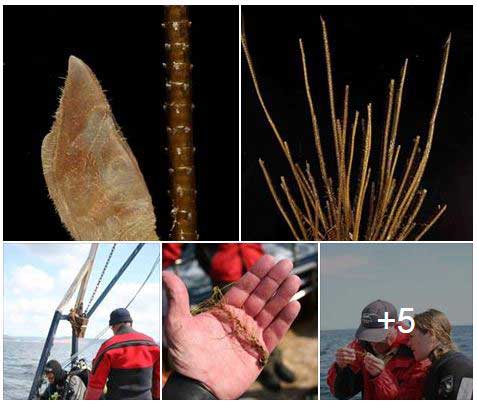 28
December 2015
28
December 2015
I
had an exciting find on Chesil
in the morning , the Stalked Barnacle Scalpellum
scalpellum, living on the hydroid Nemertesia
antennina, or Sea
Beard, unlike the other stalked barnacles
we are finding attached to flotsam, this species is British, living attached
to hydroids on the reefs of Lyme
Bay. In 2010
we collected specimens for Danish scientists who were struggling to find
the species. It was only because I had found them on the beach that we
knew they occurred in Lyme Bay, diving at 30 meters on hydroid covered
reefs paid off.
23
December 2015
A
Loggerhead
Turtle,
Caretta
caretta, was rescued at Chapmans
Pool, Dorset.
Late
November - December 2015
Debris
washed across the Atlantic Oceans hosted pelagic
visitors rarely, if ever, recorded in British seas.
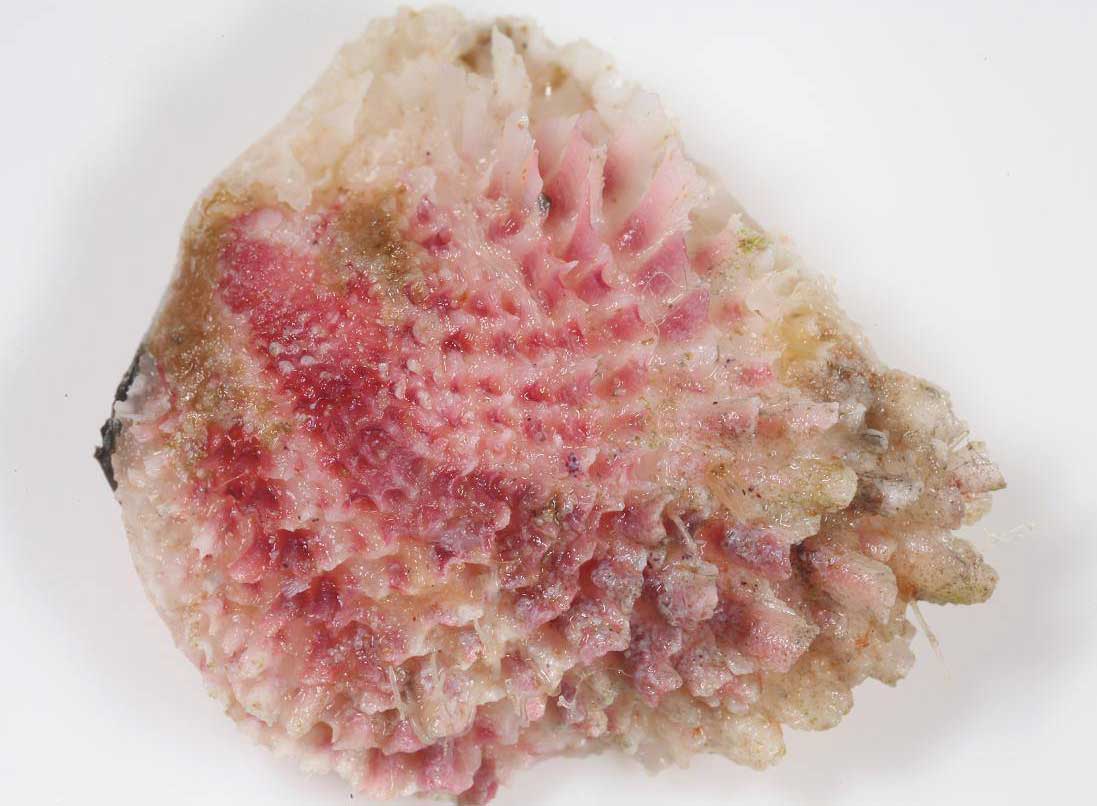 |
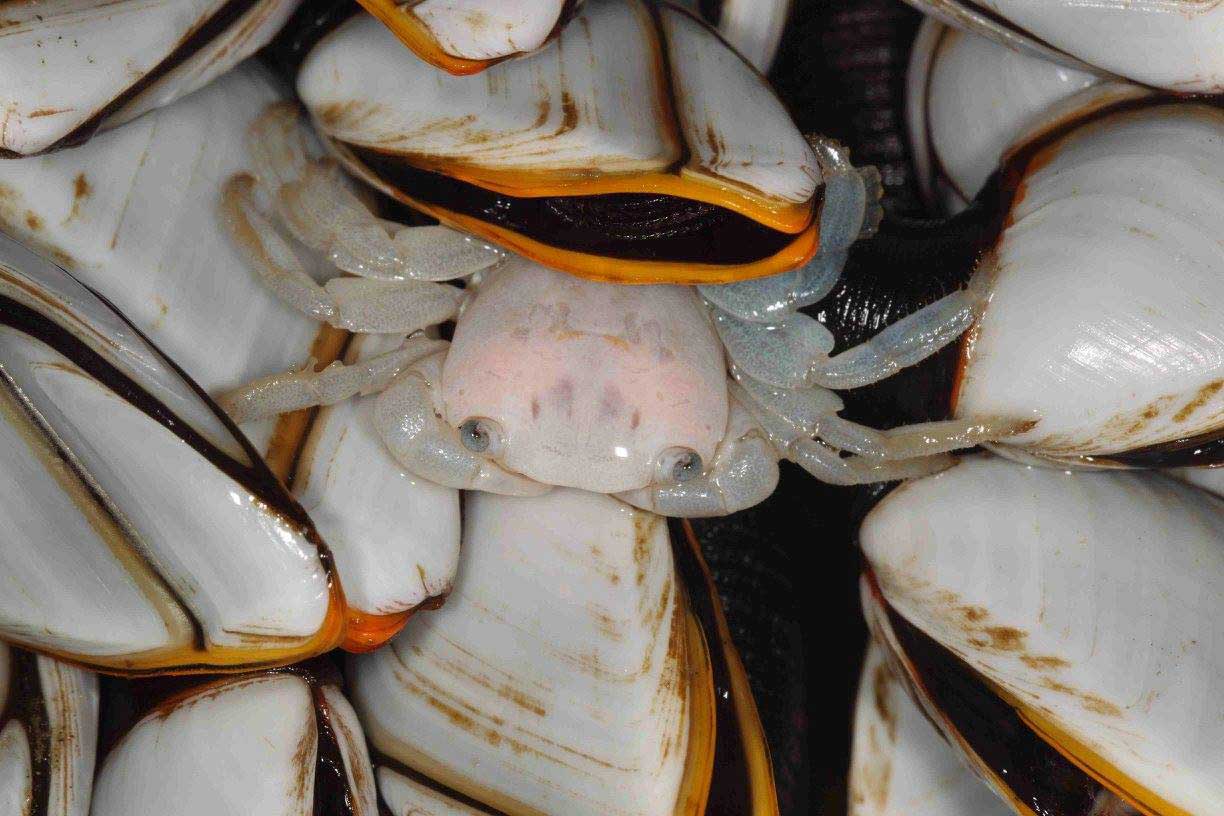 |
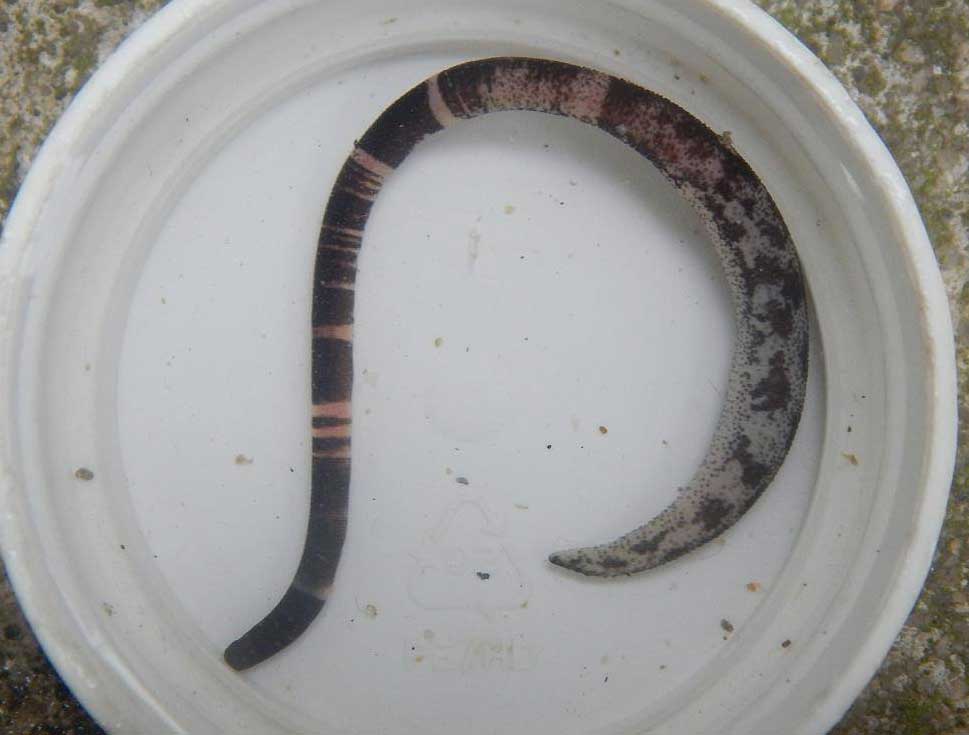 |
|
|
|
Phascolosoma (Phascolosoma) granulatum |
The
finds included
FloridaRock Shells, Stramonita
floridana, found by Steve
Trewhella living on a Goose
Barnacle covered long line buoy found at Chapmans
Pool, Dorset; over fifty tiny Columbus
Crabs,
Planes minutus. amongst
the wrecks; miniature amphipods Caprella andreae;
and a very special find of the tubes of the tiny Thimble
Jellyfish Linuche
unguiculata, by Steve
Trewhella on Chesil
Beach, and by David
Fenwick Snr in Cornwall on flotsam.
 |
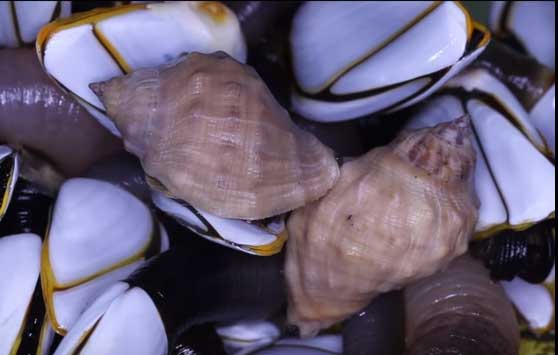 |
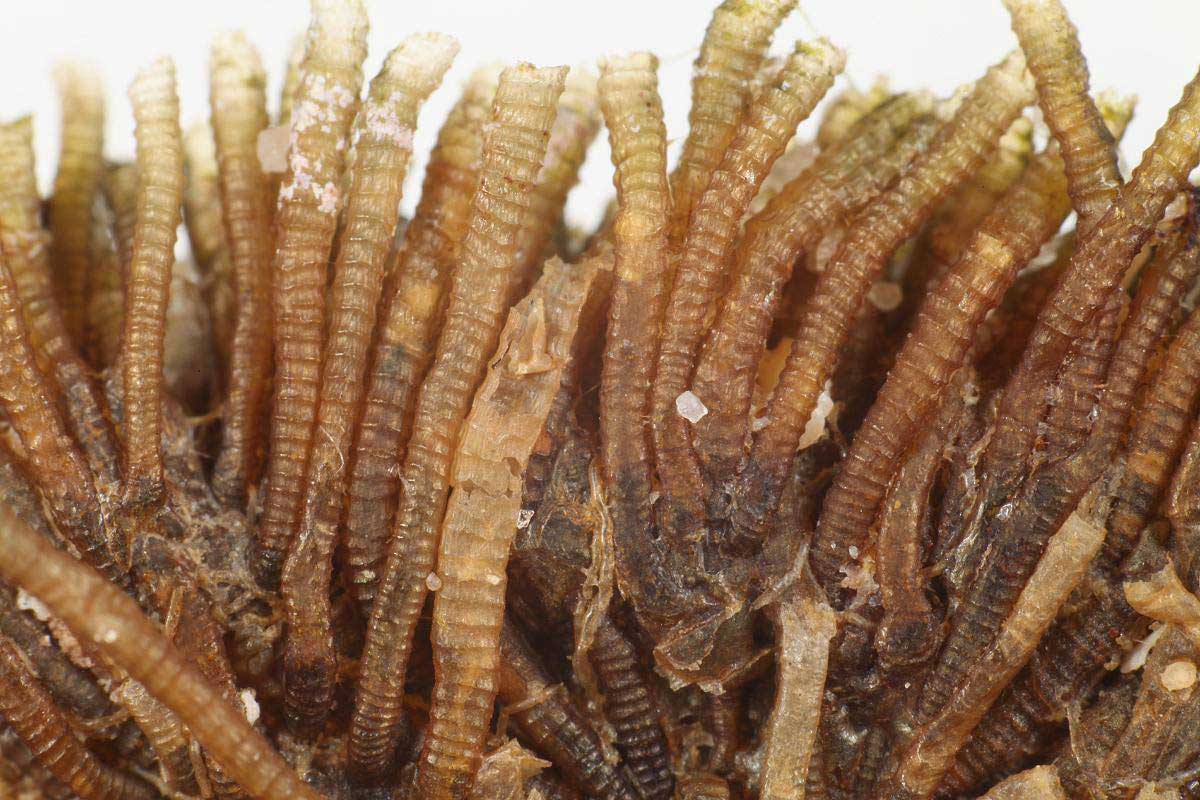 |
|
|
|
|
Also, three 60 mm long native sipunculans Phascolosoma (Phascolosoma) granulatum were found inside a buoy with seven Columbus Crabs washed ashore on Cornwall. In November another vagrant washed in from America was the Pretty Jewel Box, Chama florida. Tracey Williams found a Scotty bait pot on a beach near Newquay, Cornwall, which contained ten attractive shells of Cerithium litteratum, a Caribbean gastropod mollusc never seen before on British mainland shores. The snails would have entered the pot as larvae, living on algae growing on the inside. David Fenwick Snr also discovered the bivalve mollusc shells of the Crested Oyster Ostrea equestris Isognomon bicolor and Isognomon radiatus all attached to the same bucket washed ashore at Marazion, south Cornwall.
November - December 2015
 |
Thousands
of clumps of Goose Barnacles,
Lepas
anatifera, attached to floating objects
have been washed ashore all along the south coast from Cornwall to Kent.
Those strandings occur very year, but it seems that more than the usual
number were discovered this winter. Diligent beachcombers have discovered
the tiny Columbus Crabs, Planes
minutus. amongst the wrecks, as well
as few of the other pelagic
Goose Barnacles like Lepas
anserifera.
Stalked
Barnacles on Aphotomarine (by Dave Fenwick)
Barnacles
at Aphotomarine
Thousands of By-the-wind Sailors, Velella velella, were washed ashore on various beaches in the south and west.
7 December
2015
A
Green
Turtle, Chelonia
mydas, was found dead stranded
at Porthmadog in
Gwynedd, Wales. The approximately 25 cm long turtle was thought to have
possibly initially stranded alive, given its very fresh condition. The
body of the turtle was recovered from the beach by Gwynedd Maritime Services
and then taken to RSPCA Colwyn Bay for storage prior to pickup and transport
for post-mortem examination by the Cetacean
Strandings Investigation Programme UK (CSIP). This
is only the ninth record of this inhabitant of tropical seas (including
the Atlantic coast of Spain and the Mediterranean Sea) found in the sea
or on the shore around the British Isles.
6
December 2015
A
Loggerhead
Turtle,
Caretta
caretta, was washed ashore alive but in a moribund condition on
the south-west Scotland shore in Ayrshire.
It was moved to Scottish Sea
Life Sanctuary (SSLS) in Oban, Argyll and Bute, for recovery and rehabilitation
at but died of hypothermia
on 9 December 2015.
The
problem is the seas around the British Isles are too cold for this tropical
turtle.
Goose
Barnacles on Space Rocket
Photograph
by Tresco Boatman
A large part of a space rocket floated across the Atlantic Ocean from Florida and acquired a large colony of Goose Barnacles, Lepas anatifera, on its one year journey. It eventually beached on Tresco, Isles of Scilly, with the assistance of local fishermen..
25
November 2015
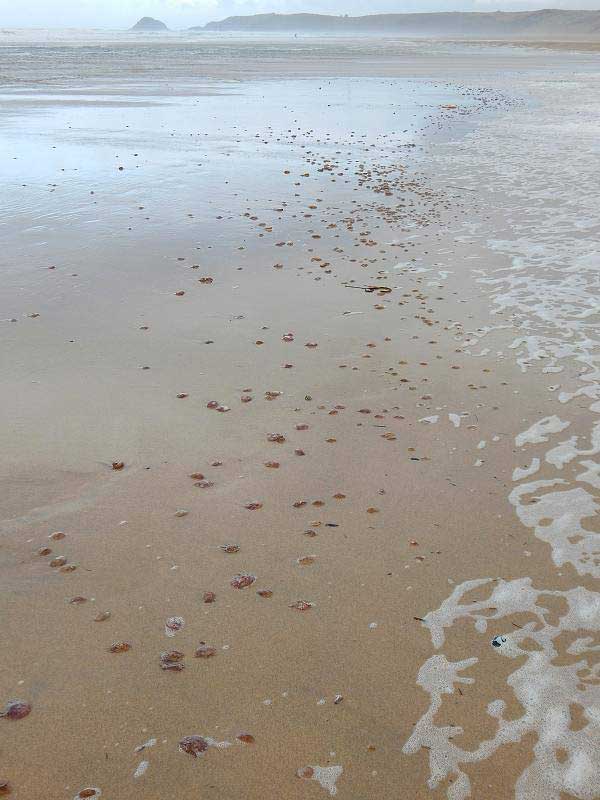 |
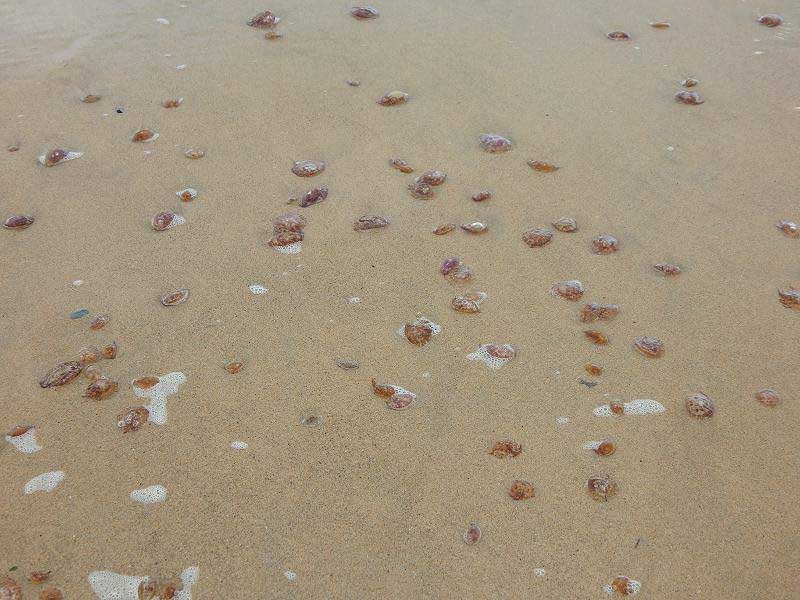 |
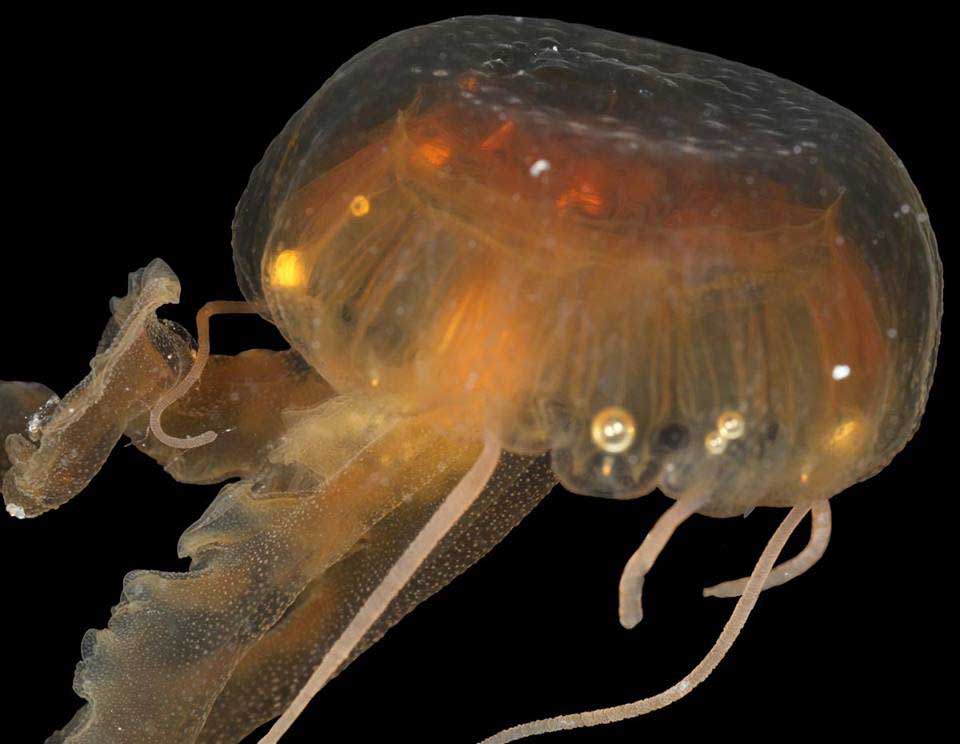 |
Mauve
Stingers at Perranporth
Photographs
by David Fenwick Snr
Ten thousands of small (about 20 mm diameter) Mauve Stingers, Pelagia noctiluca were washed ashore on Cornish beaches, notably at Perranporth and Porthtowan and other locations on the exposed north coast of Cornwall. This small jellyfish has a reputation a a stinger.
November
2015
 |
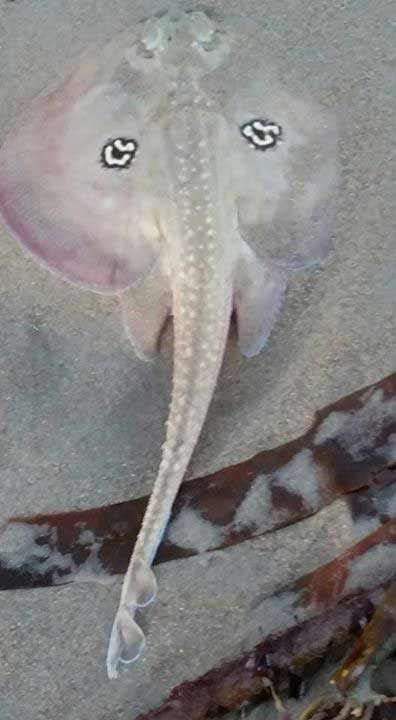 |
|
Photograph by Robyn Shilland |
Photograph by Larry Dunne |
15
June 2015
A
Swordfish,
Xiphias
gladius, was
washed up dying on Severn
Beach at the mouth of the River Seven where the Bristol Channel narrows.
It was two metres in length, including the long bill.
June
2015
Thousands
of jellyfish have been reported off the south-western
and western coasts off Britain, notable off Dorset and Wales. By far the
most noticeable have been the large Barrel
Jellyfish, Rhizostoma octopus
but also the huge stinging Lion's Mane
Jellyfish,
Cyanea capillata.
Barrel
Jellyfish washed up at Sandbanks,
Dorset
Photographs
by Lisa Harris
The
diameter of the bell in these jellyfish were up to 75 cm.
BMLSS
Jellyfish
22 January 2015

Barrel
Jellyfish, Rhizostoma octopus
Photograph
by Margaret
Burton
Two large Barrel Jellyfish, Rhizostoma octopus, were discovered washed up on the shore at Lancing.
Dealfish
Photographs
by Senga Millar
An adult Dealfish (Ribbonfish family), Trachipterus arcticus, was spotted actually swimming offshore in Scapa Flow at Bu in Orphir, Mainland, Orkney. "It was alive as we watched it swim inshore then we went back down with the camera it was on the rocks." Alas, this large 150 x 30 cm (5 ft x 1 ft) and rather distinctive silvery fish, with a long bright orange dorsal fin, perished as would be expected out of its normal deep sea environment. This unusual fish usually lives at depths of over 300 metres.
Previous Report 201426 December 2014
A large stranding of Heart Urchins, or Sea Potatoes, Echinocardium cordatum, occurred off the west coast of Scotland on including Troon and also Prestwick Beach. They were not freshly dead as the tests had lost their spines. The tests washed ashore in the gales.
21
December 2014
Two
young Kemp's Ridley Turtle,
Lepidochelys
kempii, were discovered on the shore
near Formby on Merseyside
and Cumbria's Walney
Island, north-west England on coasts facing the Atlantic Ocean. The
critically-endangered turtles usually inhabit the Gulf of Mexico, but may
have been "cold-stunned" by a drop in ocean temperatures. These young turtles
were still alive but in poor condition. These
endangered turtles breed on the coasts of Mexico and are usually found
in the Gulf of Mexico
and were thought to have blown across the Atlantic Ocean. The turtles are
likely to have suffered in the cold seas and would have succumbed if they
had not been rescued.
20
December 2014
A
huge wreck of jellyfish and pelagic jellyfish-like
animals occurred on the north coast of Cornwall with tens of thousands
of By-the-wind Sailors,
Velella
velella, washed ashore on various
shores, and a thousand plus Mauve Stinger
Jellyfish, Pelagia
noctiluca, at Sennen
Cove, Watergate
Bay
and Fistral Beach
(Newquay). The stranding
also included thousands
of Goose Barnacles,
Lepas
anatifera.
5
December 2014
A
two metres long Shortfin Mako Shark,
Isurus
oxyrinchus, was washed ashore dead on
the vast sandy shore at Barmouth,
Cardigan
Bay, west Wales.
 |
Barmouth
Shark
Photograph
by
Harry
Allday
|
Identification of the the Mako and Porbeagle, Lamna nasus, is difficult and I determined it to be the rarer Mako from the shape of the first dorsal fin lacking a white patch. It is difficult because of the pointed snout and position of the secondary dorsal fin I first thought it was a Porbeagle. Teeth may indicate a Porbeagle? Porbeagle & Mako ID BMLSS Sharks Barmouth
Shark Dorsal Fin
|
|
4 November
2014
A
tropical Oceanic Pufferfish,
Lagocephalus
lagocephalus,
was discovered washed up dead on Chesil
Beach, Dorset, by Richard
Fabbri, having been swept on to pebbles
by the high tides. The fish was 30 cm along from
head to the base of the caudal fin, but was actually longer than this because
this fish inflates itself like a balloon to make it bigger to discourage
predators. It does not make a good meal, especially
for humans, because the fish more than likely contains a toxin tetrodotoxin
sufficiently harmful enough to cause death to anyone eating the fish without
expert culinary preparation. It is advisable not to even touch the fish.
Oceanic
Pufferfish
Photograph
by Richard Fabbri
The Oceanic Pufferfish is normally found in tropical seas and is a very rare and surprising discovery in the English Channel.
Previous Report 20061 June
2014
At
Shell
Island,
Llanbedr,
Gwynedd, North Wales LL45 2PJ. I saw thousands of Common
Starfish, Asteria
rubens, washed up on the shore, some
dead and some dying. Many were a washed out white and long dead, others
were pink/orange and some were purple. Most were of equal size, roughly
10 cm across, though there were a large number half that size.
Late
March 2014
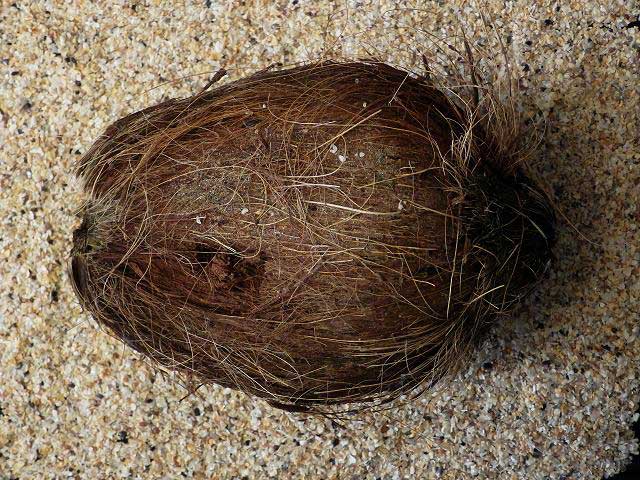 |
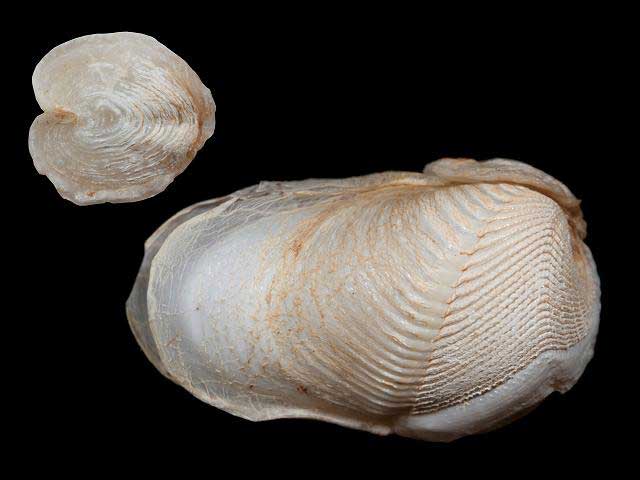 |
Coconut
& Martesia
fragilis
Photographs
by Dave Fenwick Snr (Aphotomarine)
Coconuts (and other flotsam) washed up on Cornish beaches can host exotic ocean travellers all the way from the Caribbean Sea. A Coconut discovered on Newquay Beach, north Cornwall, was discovered to be hosting Goose Barnacles, Lepas anatifera,attached to the outer husk, and two species of Martesia piddock that had burrowed into the shell. These were identified as the vagrant and rarely recorded Striate Piddock, Martesia striata, as well as the first British record of Martesia fragilis.
Beached wood and tree trunks may also contain other organisms like small crabs hitchhiking a ride or more likely burrowing Teredo (=shipworms) molluscs including the Big-eared Shipworm, Psiloteredo megotara. found in a tree trunk on Par Beach, south Cornwall.
 28
February 2014
28
February 2014

Dealfish
Photographs
by Traff
Cammish
The
Dealfish
(book
name) is a mesopelagic
deepwater fish and it appears that it is not all that common even in the
sea depths of 300 to 600 metres (or 183 to 914) metres form which it has
been reported from the NE Atlantic, not normally including the North Sea
(but more than one record held by
the BMLSS). We have received occasional reports
from off the Scottish islands. It may be a frequently caught fish in the
Blue
Whiting, Micromesistus
poutassou, fishery at depths of over
500 metres off Ireland.
Live
Fish Image
Bathyl
Zones
Previous
Report
2006
Reports
Two
further Dealfish
have been reported washed up since the first discovery. The second
one was discovered dead on the shore at Peterhead,
north-east Scotland, and the third
discovery was a decayed specimen on the beach between Marske
and Saltburn in north-east England. There
were probably more washed up and left unreported amongst the flotsam
and jetsam after the recent storms.
 |
24
February 2014
A Zulu Fish, Capros aper, was discovered by Jess Hughes washed up dead on the shore at Gyllyngvase Beach in Falmouth, Cornwall. |
13 February 2014
A dead Lumpsucker, Cyclopterus lumpus, was discovered washed up on Lancing Beach.
Adur Coastal Reports3 January
2014
Waves
battered the south and west coasts of Britain throughout the day, from
Cornwall and the south coast, all up the western coasts to Scotland, propelled
by high spring tides, gale force winds
gusting to storm force and higher, and a small*
storm
surge. The most dramatic storm damage occurred when a large area of
sandstone
cliff at Rock-a-Nore
(now part of Hastings,
East
Sussex) fell into the sea at about 1:30
pm. There was also an appreciable chalk
cliff fall near
Birling
Gap in East Sussex.
(*The
storm surge was 0.5 metres at Newhaven, Sussex.)
Strandline
at Dawlish (south Devon)
on facebook
Photographic
Gallery by Andrew
Cleave
Starfish and sand burrowing molluscs like cockles were deposited on the strandline in addition to the usual collection of Mermaid's Purses, whelk egg cases, etc. A Grey Triggerfish, Balistes capriscus, was washed onshore off the Gower, south Wales. The power of the waves was strong enough to move the sand in the shallow water and cause erosion of the shoreline and large displacements of sand and shingle.
20
October 2013
A
deep water Greenland Shark,
Somniosus
microcephalus, was found freshly dead
stranded at Embleton
Bay in Northumberland. The three metres long female shark was recovered
by staff of Newcastle University
and held frozen at their Dove
Marine Laboratory at Cullercoats. The Cetacean
Strandings Investigation Programme (CSIP) retrieved the shark
whilst carrying out demonstration necropsies for undergraduates at Newcastle
University and transported it to the Natural
History Museum in London, who have (Autumn
2014) completed preparing the shark as a specimen
for the national collection. This
large species of shark (> 7 metres & 1,400 kg) is usually found at
depths of 1000 metres in the Arctic and boreal Atlantic and is both rarely
recorded around the British Isles and relatively little is known of it
biology and bionomics.
30
January 2013 >
A
sea
bird wreck occurred along the Jurassic
Coast of Dorset and further away off Devon and Cornwall. Hundreds
of birds have been washed ashore in a poor condition because they were
coated in an oily waxy substance. Most of the hundreds of bird victims
were Guillemots, Uria
aalge,
who dive under the water far out to sea.
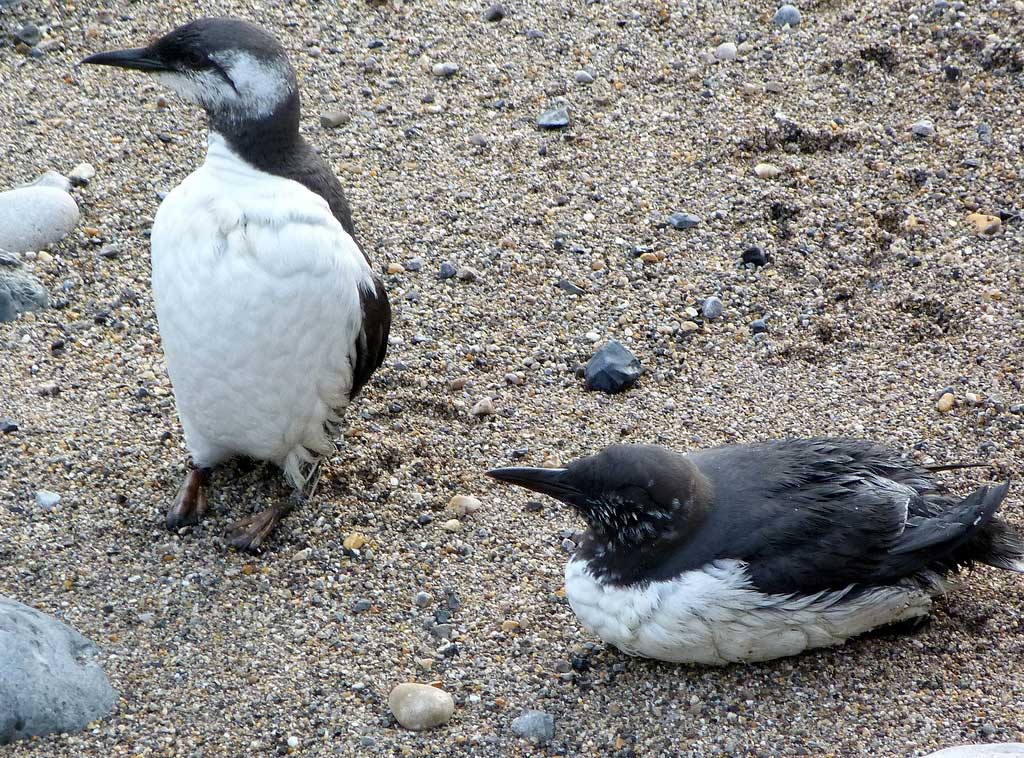 |
The
sea was very very rough and these two Guillemots were
looking bedraggled and tired in a sheltered cove on Portland
Bill, and so I thought that was the reason they were there but have
now been informed that there have been hundreds of these found covered
in a waxy substance between Cornwall and Hampshire so its likely that these
two have been affected.
Photograph and comments by Pam Parsons on flickr |
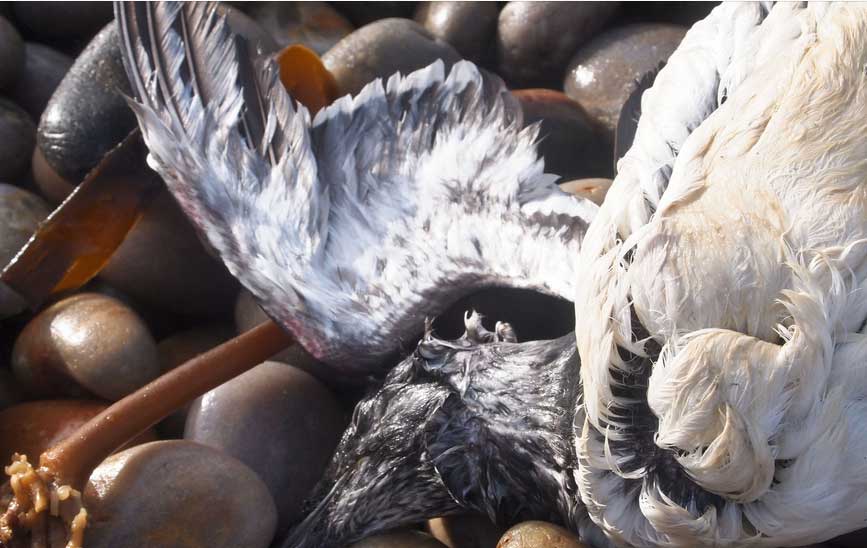 |
This
Guillemot
was
washed ashore dead at
West
Weares,
Chesil Beach,
Isle
of Portland,
Dorset. There is not always an obvious cause of death, but the bird probably
perished because it got caught in the polluted sea. Even
small coatings of the waxy substance would have prevented the bird fishing
and preening. Guillemots will
live and feed offshore in the first two months of the year rarely coming
close to land, unless injured or blown in by a gale.
Photograph and comments by Jason Hoad on flickr |
Plymouth University have identified the sticky substance as a form of polyisobutene (PIB), which was used as a lubricating additive in oils to improve performance. It is slow to biodegrade and difficult to remove from the affected birds which will die without treatment. Many of the birds were washed ashore already dead.
History of the Spillage14 December 2012
The south-east storm threw up at least six species of fish into the boat noust at Frustigarth on the east side of Shapinsay in the Orkney Islands. There were at least 30 fish of various sizes. Species identified were Tadpole Fish, Ling, young Cod, Saithe, and both Cuckoo and Ballan Wrasse. Similar wrecks occurred on other coasts.
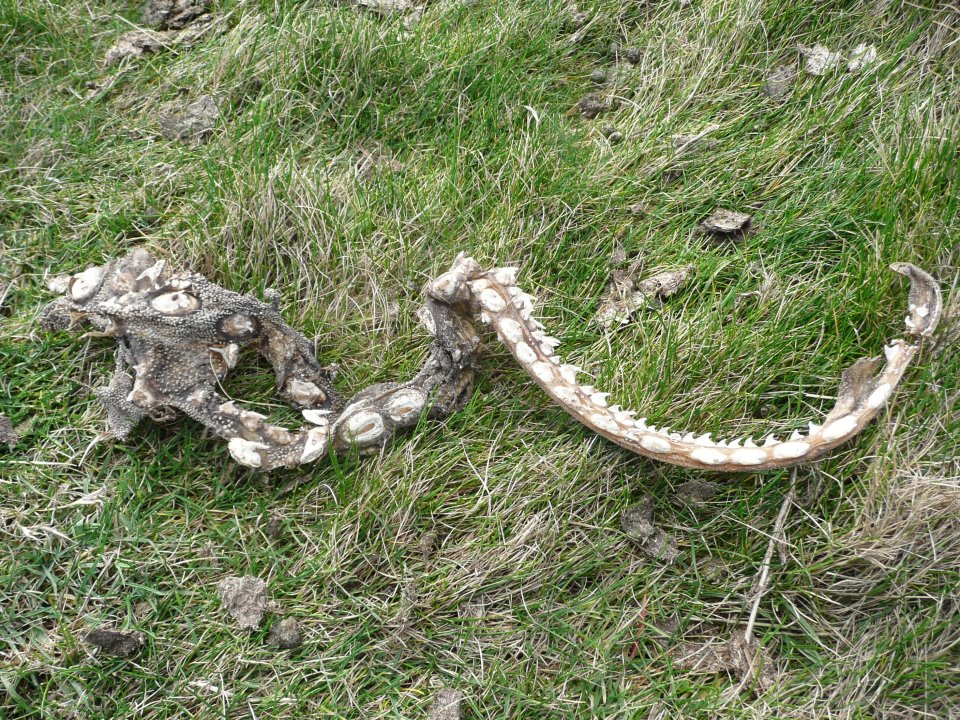
Remains of a Thornback Ray
Click on the image for more information
 |
16
December 2011
A Ray's Bream, Brama brama, was found at mouth of Brunstane Burn SE of Portobello Beach, Edinburgh. Report
and Photograph by Kevin Ingleby
|
15
December 2011
An
interesting large piece of wood was washed up on the strandline at after
storms on low tide at Sennen Cove,
Cornwall: it was completely covered in small to medium sized Goose
Barnacles,
Lepas anatifera.
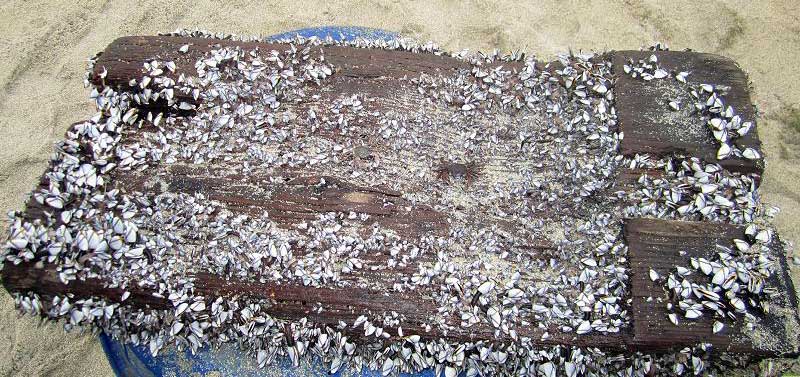
On closer examination it was found to have a cavity at one end and tucked into this was a male and a female Columbus Crab, Planes minutus. Small 3-4 mm egg masses and shipworm holes were also seen which included the rarely recorded Bankia gouldi; as well as Teredora malleolus, which made up about 95% of the shipworms in the timber. Under a magnifying glass and discovered a rare 14 mm pelagic sea slug, Fiona pinnata, which has only been recorded a few times in British seas.
|
23 November 2011 An extremely rare record of a Yellowfin Tuna, Thunnus albacares, was discovered and photographed by Nigel Jones at the foot of a cliff at Dunraven Bay, near Porthcawl, South Wales. The fish was identified from the photographs. It was only the third discovery on record from British seas. Photograph
by Nigel Jones
Report & ID by Doug Herdson (Fish Information Services) |
 |
19 November 2011
A Grey Triggerfish, Balistes capriscus, measuring 23 cm long, was washed up on the shore of the Gann Estuary near Dale, Pembrokeshire. It was found on a particularly windy day, with substantial wave action on the northern shores of the Milford Haven Waterway.
24
November 2011
Cornwall
Wildlife Trust’s Marine Strandings Network (MSN)
Annual
Conference Report
6 November
2011
Portuguese
Man-o'-War, Physalia physalis,
and
Mauve Stingers, Pelagia
noctiluca, as well as Goose
Barnacles, Lepas anatifera, were discovered
washed ashore at Kennack
Sands, on the eastern shore of the Lizard
Peninsula, south Cornwall.
Image
by Kennack Diving
8 October
2011
I
found three Portuguese Man-o'-War, Physalia
physalis, loads of By-the-Wind Sailors, Velella
velella,
Buoy
Barnacles,
Dosima fascicularis,
and Goose Barnacles, Lepas anatifera,
at Sennen Cove and
Gwynver
Beach, Cornwall.
Image
by Paul Semmens
6
January 2011
A
mass stranding of crabs occurred on the Isle
of Thanet
coast, Kent; about 40,000 Velvet Swimming Crabs,
Necora
puber, were discovered on the strandline
amongst lesser numbers of molluscs, sea
anemones, sponges and other washed up invertebrates.
The
most likely reason for this mass death was hypothermia.
19
December 2010
I
counted 33 Grey Triggerfish,
Balistes
capriscus, washed up on a half mile stretch
of beach across Porth
Kidney Sands, Lelant, Cornwall,
12
December 2010
23
mature Grey Triggerfish,
Balistes
capriscus, were washed up dead on Porthcurnow
Beach in Cornwall in the afternoon.
21
November 2010
An
unprecedented stranding of over a hundred Barrel Jellyfish Rhizostoma
octopus were discovered on the beach at Formby,
north Liverpool.
"The jellyfish were literally
uncountable - we walked about a mile along the beach and they stretched
the whole way and out of sight. They were all more than 60 cm in diameter.
The previous high tide was accompanied by a moderate
wind but nothing exceptional, and it was not particularly high."
Two
days later, almost all the jellyfish had disappeared with just a few seen
stranded on the shore.
18
November 2010
A
Grey
Triggerfish,
Balistes
capriscus, was photographed
washed up dead on the shore at Ceibwr,
North Pembrokeshire, SW Wales.
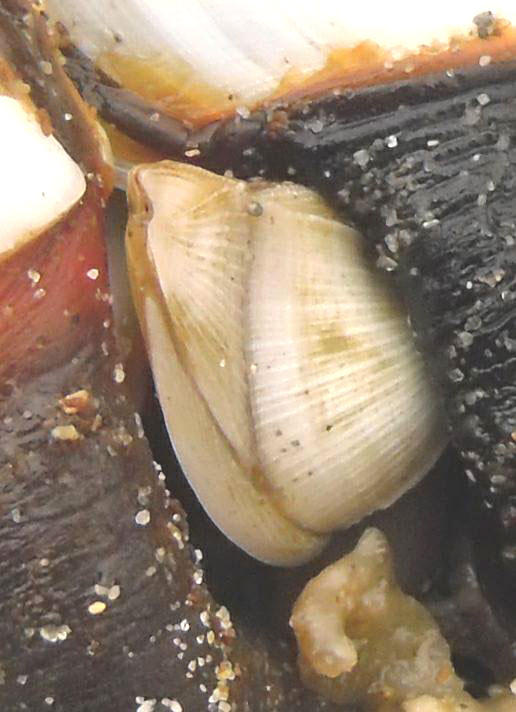 |
3
November 2010
At least three species of Stalked Barnacles, Lepas hilli, Lepas pectinata and Lepas anatifera were discovered on the high tide mark at Long Rock, Penzance, Cornwall. Strong south-westerly winds had washed ashore a large plastic lid that the animals were attached to. This is a pelagic tropical-sub-tropical species that is blown to the UK shores on flotsam via the Gulf Stream. British seas are too cold for these species to survive and breed. Report
and Photograph by Dave Fenwick
Barnacles at Aphotomarine |
|
|
|
 |
1
November 2010
A Ray's Bream, Brama brama, was washed ashore at Portobello Beach, Edinburgh. Report
and Photograph by Kevin Ingleby
BMLSS
Ray's Bream Reports |
20 September 2010
Common Dolphin, Delphinus delphis, washed up dead at Trebarwith Strand, on the north coast of Cornwall
Photograph by Joly on Sandercock
ID
by Caroline Weir on UK
Cetnet Yahoo Group
ID
confirmed by Dr Kev Robinson
(CRRU)
 |
The carcass of a baby cetacean was washed up on the shore at South Heacham Beach, Norfolk. It was about a metre long and the skull about 23 cm. It is most likely to be a baby Harbour Porpoise, Phocoena phocoena.
17
July 2010
I
made a wonderful but sad discovery as I walked along the pebbles at Chesil
Cove, Dorset. At first, I could not take in what I was looking at because
it looked, somehow, so artificial – like a large model or toy. This exquisite
creature was a newly born (neonatal) Risso’s
Dolphin, Grampus
griseus.
The stranded body of this small dolphin was about 1.3 metres long. It looked unlike any dolphin I had ever seen before and was clearly not a Common or Bottle-nose Dolphin as it had no ‘beaked’ snout. The odd shape of the head is characteristic of this species as also with the dorsal fin, pectoral fins and the tail flukes.
Flung ashore by huge waves, it was virtually unmarked but for a few grazes and scratches on head and under-belly. The smooth, cold, rubbery skin shaded from almost black, through grey and tan to near white; unblemished and scarless with just a few fine lines and creases where the fins articulated with the body and in the places most stretched – like the jaw line. Apparently the broader barely perceptible marks along its sides are foetal folds and the chief indicator that it had recently been born.
Full Report & Images on Jessica’s Nature BlogBMLSS
Cetacea
BMLSS
Whales & Dolphins (by Steve Savage)
 14
March 2010
14
March 2010
Thousands
of Common Starfish,
Asterias
rubens, were washed up on the strandline
on the shingle beach at
Budleigh
Salterton in south Devon (East
Devon AONB). The line of washed up starfish
stretched for over a mile.
3 March
2010
A
mystery silvery fish with red dorsal fins washed
ashore dead on the Isle of Mull, western Scotland was discovered to
be a Dealfish
(Ribbonfish
family),
Trachipterus
arcticus.
This
deep water fish is uncommon at depths of over 180 metres and deeper and
it is rarely washed ashore.
January
2010
At
least fifty Ray's Bream,
Brama
brama, were discovered over a period of a few weeks by the beach
cleaning staff between Roker
and Seaburn, at Sunderland,
Wearside,
north-east England.
13
January 2010
A
mass stranding of crabs occurred on the Isle
of Thanet
coast, Kent; the crabs have been reported on beaches
at Westbrook, Cliftonville
and Kingsgate,
while smaller numbers have been washed up between Broadstairs
and
Ramsgate. Most
of the crabs were the Velvet Swimming Crab,
Necora
puber, which inhabits the shallow seas beneath
the intertidal zone, over rocky substrates.
9
December 2009
An
exceptional mass stranding of millions (a galaxy) of Common
Starfish,
Asterias
rubens, stretched in a broad band for over a quarter of a mile
on Holkham Beach on
the north coast of Norfolk.
Their
usual residence would be feeding on the mussel
beds offshore. From a previous occurrence underneath the chalk cliffs east
of Brighton Marina,
Sussex, it is my surmise that the mass migration occurs because the Common
Starfish have exceeded their food supply offshore.
Perhaps, this occurs because of commercial dredging of the mussels.
In this case the stranding could have been exacerbated by north-easterly
gales.
5
December 2009
We
discovered two Sunstars,
Crossaster
papposus, on the beach at Winthorpe, Lincolnshire.
We have never seen these before on this coast although the five legged
Common
Starfish,Asterias
rubens, are quite common.
4
November 2009 - 30 December 2009
Ray's Bream
 |
 |
 |
|
Photograph by Vic Mackinder |
|
|
Frequent
reports of Ray's Bream,
Brama
brama, being washed ashore on North Sea were received. These strandings
occurred in 2008
and earlier years.
List
of 2009 Reports
More
Reports of Ray's Bream on flickr
> 24
December 2009
Strong
south-westerly winds have blown many organisms on to Dorset beaches including
the unusual pelagic Striped Goose Barnacle,
Conchoderma
virgatum, and at Ringstead
Bay, near Weymouth a tiny Columbus
Crab,
Planes minutus,
was discovered.
9 December
2009
An
exceptional mass stranding of millions (a galaxy) of Common
Starfish,
Asterias
rubens, stretched in a broad band for over a quarter of a mile
on Holkham Beach on
the north coast of Norfolk.
Their
usual residence would be feeding on the mussel
beds offshore. From a previous occurrence underneath the chalk cliffs east
of Brighton Marina,
Sussex, it is my surmise that the mass migration occurs because the Common
Starfish have exceeded their food supply offshore.
Perhaps, this occurs because of commercial dredging of the mussels.
In this case the stranding could have been exacerbated by north-easterly
gales.
5
December 2009
A
Common
Octopus, Octopus vulgaris, was
washed up dead on Salthouse
Beach, North Norfolk after a week of strong northerly winds and quite
rough seas, resulting in a variety of finds along the shoreline.
The octopus was
found by local diver Rowley Nurse
whilst walking his dog along the shore.
We discovered two Sunstars, Crossaster papposus, on the beach at Winthorpe, Lincolnshire. We have never seen these before on this coast although the five legged Common Starfish, Asterias rubens, are quite common.
November
2009
Six
species of barnacles were found in a week
of sightings at Chesil
Beach, Dorset:
Buoy
Barnacle Dosima faciculalaria,
Scalpellum
scalpellum
Four
species of Stalked Barnacles:
Lepas
anserifera, Lepas hilli, Lepas pectinata
and
Lepas
anatifera.
About
5:00
pm on the shore of Barry
Island beach, Vale of Glamorgan, South Wales, a chap spotted a fin
sticking out of the water and hauled in a dead Broad-billed
Swordfish,
Xiphias
gladius,
watched by a swarm of congregating gulls. The
last British report was also washed up on Barry Island in July
2008.
They
are often called a Broad-billed Swordfish,
but
there is only one species in the world. They are found throughout the tropical
and temperate waters of the world but appear to prefer sea temperatures
of 18° C to 22°C, migrating to cooler waters to feed in the
summer. These oceanic fish chase herring and mackerel
and are among the fastest fish reaching 90 km.h-1 (56 mph). This is in
part due to their being warm-blooded, which allows not only their muscles
but also their brain and eyes to work more efficiently.
18
May 2009
A
large wreck of
millions of By-the-Wind Sailors, Velella
velella,
started getting washed ashore and extended, at least several miles east
from Penzance, south Cornwall.
 |
 |
The specimens are very small, only a few millimetres in length. More Velella arrived on each tide.
A previous mass stranding of amphipods occurred on the North Sea coast in 1966.
Thousands
more were discovered washed up at Whitby
in North Yorkshire.
13
May 2009
About
50 specimens of the Bluefire Jellyfish, Cyanea
lamarcki, were washed up on Havelet beach, on the south
side of St. Peter Port, on the east coast of Guernsey and recorded at 5.19
pm.
The jellyfish in the image measures about 30 cm across but most were much smaller.

ADUR WORLD OCEANS DAY
Understanding and celebrating our marine environmentSaturday 6 June 2009
10:00 am to 4:00 pmon Coronation Green, Shoreham-by-Sea, Sussex,
as part of the Adur Festival
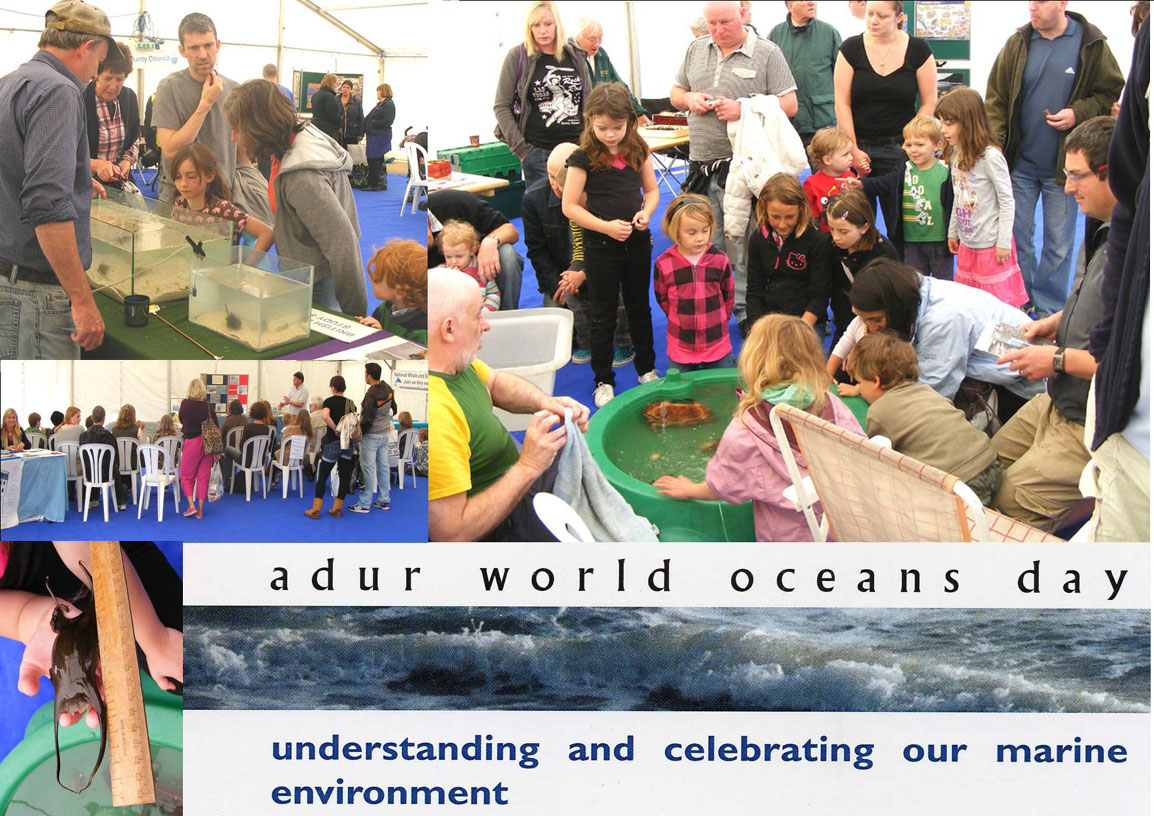
Adur was one of the UK leaders in presenting the eleventh environmental exhibition of World Oceans Day on Coronation Green, Shoreham-by-Sea.
Adur World Oceans Day took place in the marquee on Coronation Green on 6th June 2009 on the opening Saturday of the Adur Festival. Len Nevell was there with the usual exhibition of lobsters and crabs. The innovative aquarium displays of seashore life, strandline exhibits and photographs will again be in on show. Experts will be on hand to answer your queries about life in the oceans and on the seashore.
I think World Oceans Day this is best described by the Nobel prize winning author John Steinbeck when writing about Ed 'Doc' Ricketts of Cannery Row fame in which he wrote 'commercial fishermen harvest the sea to feed men's bodies and a marine biologist harvests the sea to feed men's minds'
Quote by Andy Horton (British Marine Life Study Society)The Friends of Shoreham Beach played an important part with their own displays and information about the Nature Reserve and plants of the shingle beach.
Len Nevell: Lobster's Meal Time
Adur World Oceans Day is run by a committee comprising representatives of the British Marine Life Study Society, West Sussex County Council, the Sea Watch Foundation, Friends of Shoreham Beach and other groups, with support from Adur District Council.
World Oceans Day was declared at the Earth Summit in 1992.
1
February 2009
An
unusual discovery washed up on the shore at Hauxley near Amble
in Northumberland on the north-east coast of England was the decaying remains
of an Oarfish (or Ribbon Fish),
Regalecus
glesne. This is a deep water species
and the longest fish found in the oceans reaching a length of 11 metres.
The
last known British record was from Skinningrove,
Cleveland on the north-east coast in 2003.
January
2009
 |
|
|
|
|
Ray's
Bream,
Brama
brama, continue their strandings on the east coast of England and
Scotland. Most of them are found dead on the beach, intact or scavenged
by gulls, whilst occasionally they are discovered alive flapping in the
shallow water surf.
More
Reports
2 October
2008
The
first By-the-Wind Sailors, Velella velella,
reported this year are washed up in small numbers between
Loch
Ewe
and Black Bay, Wester
Ross,
on the west coast of Scotland. The White-tailed
Sea Eagle, Haliaeetus
albicilla,
can be seen in this area. Its main diet is
reported to be other sea birds including Fulmars
and Kittiwakes.
BMLSS
Velella
Gairloch
Marine Life Centre
Eagles
& Crofters
30
August 2008
Portuguese Man-o'-War, Physalia physalis, washed up on Pendine Sandsin Carmarthenshire, south Wales.
Photograph and Report by Chris English
Broad-billed
Swordfish
Photograph
by Colin Smith
(Amgueddfa
Cymru - National Museum Wales)
A Broad-billed Swordfish, Xiphias gladius, was discovered washed up dead on Barry Island beach, Vale of Glamorgan, South Wales. It was carefully examined by Dr Peter Howlett, (Curator of Lower Vertebrates, National Museum, Wales) who confirmed the identification and found it to be a young specimen 2.24 metres long and between 60 and 80 kg in weight. It had been dead only a few days, but it had been scavenged by other creatures and it was not possible to determine the cause of its death.
Full
Report
BMLSS
Swordfish Reports
April
2008
 |
|
26
March 2008
After
a recent bout of northerlies in North Wales I took the dog for a walk down
on Red Wharf Bay
on Anglesey and found
all sorts of things washed up. Much of the material was deposited across
the entire intertidal to the east of the bay, but more concentrated on
the strandline towards the west.
Brittlestars
(various species) were particularly abundant on the upper shore, with patches
a couple of inches (or more) thick. Common
Starfish,
Asterias
rubens, were also very abundant, as a rough guess at 5-10
per square metre. Species such as the Sand
Starfish Astropecten
irregularis, Heart Urchin Echinocardium
cordatum,
Dead Men's Fingers Alcyonium
digitatum, Masked Crabs,
Corystes
spp., and various sipunculids (Peanut Worms)
were
also washed up in considerable numbers, as were various shark
and ray eggcases, a couple of which I
brought back to ID. Of the more unusual species, I found three Angular
Crabs, Goneplax rhomboides, a small
Conger
Eel (approx. 50 cm long) and a dead Chough,
Pyrrhocorax
pyrrhocorax.
 |
 |
Over Easter, after some heavy storms with snow blowing in off the North Sea, I discovered hundreds of thousands of Razorfish, Ensis sp. (a bivalve mollusc), hundreds of Common Starfish, Asterias rubens, lots of Sunstars, Crossaster papposus, and Brittlestars washed up on the sands of Holkham Beach.
 |
 |
 |
Hundreds of the sea cucumber Thyone fusus, many exuding their guts and gonads as a response to the stress, were discovered washed dead on up on the shore Newborough , Anglesey, in North Wales (only a few nautical miles from Dinas Dinlle).
4 February 2008
After the recent storm there was a mass stranding on Lancing Beach east at low tide. I braved the chill westerly breeze and found the usual 'Mermaid's Purses' Dogfish Eggcases (including three with embryos seen inside), Ray Eggcases, orange and white sponges, Whelk shells and eggcases Buccinum, and also hundreds of dead sea anemones, including dead and alive Snakelocks Anemones, Anemonia viridis. and larger Dahlia Anemones, Urticina felina.
23
January 2008
 |
 |
Two 'Mermaid's Purses', containing the eggs or young of the Lesser-spotted Dogfish, Scyliorhinus canicula, were found lying amongst the timber and seaweed debris on the strandline of Shoreham Beach.
22
January 2008
 |
 |
A dead
Short-snouted
Seahorse, Hippocampus
hippocampus, was discovered by Craig
Vernoit on Brighton
Beach just to the east of Brighton
Marina amongst tonnes of timber
from the Greek-registered Ice Prince.
BMLSS
Seahorses
21
January 2008
 |
 |
Timber
from the Greek-registered Ice Prince,
which sank about 26 miles (42 km) off Dorset after a storm on 15
January 2008, began getting washed up on Worthing
Beach in the evening of 18 January 2008
and
and tonnes of pine planks littered the Sussex
beaches from 20 January 2008. The
usual debris was on the
strandline including
the eggcase of an Undulate Ray, Raja
undulata. It measured 67 mm long and 48
mm wide.
A
Bottle-nosed
Dolphin, Tursiops truncatus,
was
washed up dead west of Brighton Marina.
BMLSS
Eggcases
BMLSS
Whales & Dolphins (by Steve Savage)
Adur
Coastal 2008
24
February 2007
A
dead Gannet,
a dead Puffin,
and other sea birds,
together with miscellaneous cargo debris were
discovered washed up on Shoreham Beach.
Dozens of pens, car parts, chocolate boxes and bars were seen. These
two sea birds are not usually washed ashore in Sussex in such a fresh condition.
 |
 |
 |
BBC
News Reports:
Stranding
Oiled
Birds
Oil
Slick
4 January
2007
Both
species of Violet Sea Snail, three
Janthina
janthina
and one Janthina pallida
with the cuttlebones
of all three species of cuttlefish
were discovered on the beach at Perranporth, Cornwall, (SW
75). The species were the Common
Cuttlefish, Sepia officinalis,
the Elegant Cuttlefish,
Sepia
elegans, and
Obigny's
Cuttlefish, Sepia
orbignyana.
2 January
2007
At
Gwithian beach, Cornwall, (SW
54), 15 Violet
Sea Snails,
Janthina
janthina,
with three dead Triggerfish,
Balistes
capriscus, and one Nightlight
Jellyfish,
Pelagia noctilica, were
discovered on the strandline.
20
December 2006
 |
 |
 |
Three Violet Sea Snails, Janthina janthina, were discovered on Marazion beach in south Cornwall.
 |
 |
A scour of the strandline between Sennen and Gwenver on the west coast of Cornwall near Land's End discovered about fifty Violet Sea Snails, Janthina janthina, seven dead Triggerfish, Balistes capriscus. and one Gulfweed Crab, Planes minutus, on a polystyrene float covered with Goose Barnacles, and two Ray egg cases.
17
December 2006
Twenty
Violet
Sea Snails,
Janthina, were discovered
along the beach at Woolacombe,
North Devon. Most were about 10 mm in size, and some were still alive with
their bubble rafts and "inked" when placed in a bucket. They were
washed in with tiny (max 12 mm) By-the-Wind Sailors, Velella
velella, Buoy Barnacles,
Dosima
fascicularis, and a small 15 cm Triggerfish,
Balistes
capriscus.
16
December 2006
A
badly decomposed Leatherback Turtle,
Dermochelys
coriacea, was washed ashore on Selsey
beach, West Sussex. There was much remaining of this large turtle, but
the distinctive outer shell and at least one flipper is seen in the photograph
by Justin Atkinson.
It is extremely unusual for a turtle up this far east up the English Channel on the northern coast.
13
December 2006
The
gales of the preceding week also brought in the remains of a Leatherback
Turtle,
Dermochelys coriacea, on
to at Widemouth
Bay near Bude in north Cornwall.
12
& 13 December 2006
On
the shore at Upton
Towans (near Hayle), Cornwall, three Gulfweed
Crabs, Planes minutus, (also known as the Floating Crab and
Columbus Crab) were discovered living among
Goose
Barnacle bases on a polystyrene float;
and on the second day at Perranporth
six of these tiny crabs were found on a plastic barrel and one on a plastic
float.
1
- 9 December 2006
The
prevailing winds of autumn and the recent gales have washed more unusual
pelagic animals on to the shore (with the millions
of By-the-wind Sailors, Velella velella,
and multiple thousands of Goose Barnacles,
Lepas
anatifera) notably the small (size
of a 10 pence piece) pelagic Columbus Crabs,
Planes
minutus, with five discovered on the Dorset
coast at Southbourne (near Bournemouth)
and a further 15 at Hengistbury
Head, Dorset. The latter was discovered inside a large shipworm-riddled,
Teredo,
pole in cavities created by the tiny burrowing mollusc.
The Columbus Crabs were
found with the Goose Barnacles
and there are clues that the buoys, wooden pallets, fish boxes etc. have
been floating around the Atlantic Ocean for two years or more and are American
in origin.
29
November 2006
About
a hundred small Goose Barnacles,
Lepas
anatifera, were seen washed up attached
to a broken plastic fish box on the strandline of Shoreham Beach (Ferry
Road access) after the recent southerly gales.
This is the first time I have seen them washed at Shoreham in over 25 years, but I expect they have been washed up and unrecorded before on frequent occasions.
26
November 2006
 Thousands
of By-the-wind Sailors, Velella velella,
are washed up on Welsh beaches, notably a narrow but continuous line of
Velella
velella washed up on the high tide mark at Borthwen,
Rhoscolyn, Anglesey (southern end of Ynys Cybi - Holy Island), north
Wales (Ian
Wright); literally thousands stranded
on a small bay at the Mumbles, Swansea (Jess
Pitman); a swarm amounting to about two
hundred were washed up on Porthllysgi beach off the coast of St.
Davids in south west Wales (Eleri
Davies); thousands, if not millions, of
By-the-wind Sailors washed up on a beach at Criccieth
(on the southern coast of the Lleyn Peninsula), Gwynedd, north Wales (Eilir
Daniels); and an armada, a thick layer
of jellyfish about a metre thick on the strandline in both directions at
Cefn
Sidan Beach at Pembrey, south west Wales (Bella).
Thousands
of By-the-wind Sailors, Velella velella,
are washed up on Welsh beaches, notably a narrow but continuous line of
Velella
velella washed up on the high tide mark at Borthwen,
Rhoscolyn, Anglesey (southern end of Ynys Cybi - Holy Island), north
Wales (Ian
Wright); literally thousands stranded
on a small bay at the Mumbles, Swansea (Jess
Pitman); a swarm amounting to about two
hundred were washed up on Porthllysgi beach off the coast of St.
Davids in south west Wales (Eleri
Davies); thousands, if not millions, of
By-the-wind Sailors washed up on a beach at Criccieth
(on the southern coast of the Lleyn Peninsula), Gwynedd, north Wales (Eilir
Daniels); and an armada, a thick layer
of jellyfish about a metre thick on the strandline in both directions at
Cefn
Sidan Beach at Pembrey, south west Wales (Bella).
BMLSS
Velella
2 November
2006
After
a period of warm southerly and south-westerly winds, the weather changed.
Strong colder winds came from the north-east and an easterly direction.
By-the-wind
Sailors, Velella velella, entered St. Peter Port harbour on
Guernsey's east coast, driven in by the wind. Commercial fisherman
Clive
Brown called to tell me that about 25 Velella
velella were washed up on the shore near his dinghy in the harbour.
I went down to the Albert marina and I was able to collect four Velella
velella by reaching out from a pontoon. This
picture shows one of them mirrored by the water's surface:
Velella
Report
& Photograph by Richard
Lord (Guernsey)
Sealord
Photography
25
October 2006
I
was approximately 5 to 6 miles west of the Casquettes, off Alderney, Channel
Islands, and I saw about ten Velella velella being blown
past our boat in a few minutes.
13 - 14 August 2006
Buoy
Barnacles on White Park Bay beach (north
Antrim)
Photograph
by Dave Harrison
Large numbers of Buoy Barnacles, Dosima fascicularis, were found stranded on the north coast beaches of Northern Ireland, e.g. Portstewart Strand and White Park Bay (County Antrim). There were at least six of these batches seen on the White Park Bay beach during the walk
Buoy
Barnacles are
attached to floats that they had secreted that have a texture like that
of expanding foam.
3 - 7 August 2006
Buoy
Barnacles from Connemara
Photograph
by Alison
Thousands of the stalked Buoy Barnacles, Dosima fascicularis, are washed ashore on the beaches of Connemara, County Galway, south-west Ireland. They were stranded all along the west coast of Ireland.
29 June 2006
I found this animal washed up on Blackpool beach, Lancashire. It was so interesting I photographed it. It was unfortunately dead or I would not have disturbed it. It was wet as I washed off dried sand which revealed its beautiful colours.
| The Runner Crab (or Square Crab), Goneplax rhomboides, is an offshore crab of muddy areas which is occasionally washed up on dead on the strandline. The crab (with a missing claw) in the photograph by Ade Jupp was found washed up at Hythe, Kent, on 24 December 2005. |  |
c.
8 April 2005
Part
of a fish skeleton was discovered on the strandline
on Shoreham Beach, Sussex, as shown in the
photograph. There were at least half a dozen of these skulls of various
sizes.
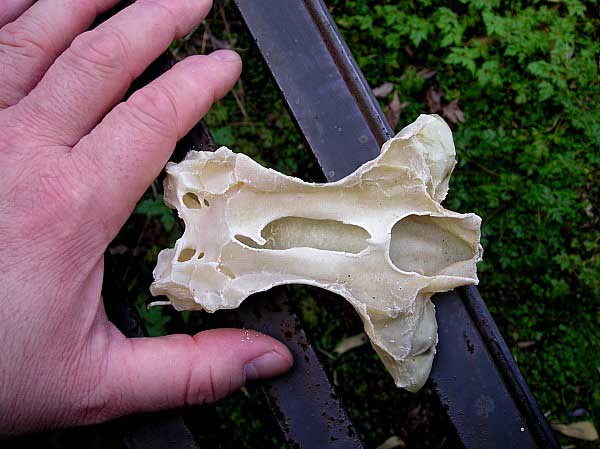 |
The skeleton has not been positively identified, but the best guess is that it is a skull of the Lesser Spotted Dogfish, Scyliorhinus canicula.
13
January 2005
Hundreds
of Sea Cucumbers were
amongst the wreck of animal remains discovered on the Dinas
Dinlle beach west of Llanwrog (south-west of Caernarfon), north-west
Wales.
 |
They were scattered all over the strandline and shore with other remains including the common Mermaid's Purses (egg cases of the Dogfish) and the decaying carcass of a dead Seal. Sea Cucumbers are an unusual invertebrate washed up between the tides. They were on the sandy shore adjacent to the Iron Age hill fort.
The sea cucumber looks like Thyone fusus can be found as far north as Norway grows up to 20 cm.
Sea
Cucumbers; General Information - 1
Sea
Cucumbers; General Information - 2
9 October
2004
A
visit to three shores in northern Cornwall brought the first report of
a Violet Snail,
Janthina
janthina, with the recent spate of
By-the-wind
Sailors,
Velella
velella, strandings. Two shells, one
alive and one dead, discovered by Julie Hatcher
(Kimmeridge Bay Marine Nature Reserve) on
Widemouth Bay beach, near Bude. The strandline
was covered in the white skeleton shells of Velella
several centimetres thick.
Not
only the shell but the soft body of the Violet
Snail is also a violet colour. This gastropod
feeds of on Velella and
secretes a mucus bubble-raft to keep in buoyant. Another animal (a crustacean)
that secretes a polystyrene-like raft to keep it afloat is the Buoy
Barnacle,
Dosima
fascicularis, which were present in their
hundreds and were still be swept in on to the beach to strand and die.
These were more numerous than at least two species of
Goose
Barnacles, the commonest was Lepas
anatifera and the other smaller one washed up was the Duck
Barnacle,
Lepas pectinata. These
two barnacles are always attached to floating debris and are not pelagic,
but sessile animals when adult and they become stranded on the shore when
the object they attach themselves to becomes dislodged and floats away.
21-23 September 2004
First
strandings on Velella on the sandy beach at Polzeath, Cornwall
Photograph
by Jonathan Smith
A huge
mass
stranding of By-the-wind
Sailors,
Velella velella, occurred
all along the north Cornish coast from Sennen
Cove (near land's End) up to Polzeath (near Padstow) and beyond. (As
the gull flies this is a distance of 25 miles and with all the coves and
inlets the shoreline is over double this.) Coming in on the top of the
tide, there were hundreds of millions* of them, all large, the largest
I found was 85 mm, and all them were intact.
Tens
of thousands of Goose Barnacles, Lepas anatifera, were washed
up along the strandline.
(*
Numbers not calculated. At Gwithian they formed a band 10 metres wide on
the shore and stretching for over a mile. The photograph understates the
extent of the stranding.)
14-21
March 2004
A
full skeleton of a small 120 cm cetacean was
discovered on the shore at
Low Newton, in Northumberland, north-east England.
Full
Report
27
May 2002
"Millions"
of Velella
velella, the By-the Wind Sailor
were
discovered by Nick Darke on
Porthcothan Beach, Cornwall. They are freshly dead, the float having the
animals or at least fragments of the soft tissue, still present. They are
probably all along the north coast, especially at Perranporth, so I will
be interested to have an idea of the maximum density per sq. metre. The
last really big incursion was in June/July
1981 when Rennie Bere
counted 150 to 200 per sq. metre, as they came in on the tide (i.e. not
heaped up in catchment areas) and he estimated 100,000 for the stretch
of shore at Bude.
 Many
By-the
Wind Sailor were also discovered washed
up further east on the shore at Kimmeridge Bay, Dorset.
Many
By-the
Wind Sailor were also discovered washed
up further east on the shore at Kimmeridge Bay, Dorset.
Largest Stranding on Record
c.
14 March 2002
After
a sustained period of north-easterly gales, there was amassive
stranding of marine animals and weed on the Yorkshire shore (north-east
England) between Fraisethorpe and Barmston (East Yorks: Holderness).
The most noticeable of the animals washed up were hundreds of thousands
of starfish mostly of the Common
Starfish, Asteria rubens, but
other species were present. The list of interesting animals washed up included
decapod
crustaceans
including Lobsters that were still alive,
crabs
etc., a wide variety of fish, sea
anemones,
polychaete worms, molluscs
including octopuses,
porpoises,
seals
and tonnes of seaweed. This is the largest stranding
recording on these web pages.
Two species are involved, mainly the Common Cuttle, Sepia officinalis, and the uncommon Sepia orbignyana (5%) which is smaller and has a pink tinge. The cuttlebones of Sepia orbignyana have longer apical spines (Matt Stribley). A range of sizes of the Common Cuttle have been seen and they are complete, with for example, no teeth marks to indicate that they have been eaten.
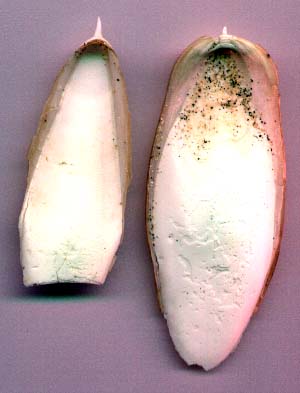
There
seems to be a lot of both cuttlefishes and squids
around this year.
The
Cuttlefish probably could have died naturally after spawning, but there
were a large numbers of smaller cuttlebones from reduced sized (juvenile?)
specimens.
You
have to be very careful with the identification of the two cuttlebones.
It is the angle of the spine that is important and you will have to go
to Matt Stribley's site below to see the small detail. In old specimens
of Sepia officinalis the cartilage
on the outside of the cuttlebone can break away and then the shape will
resemble that of Sepia orbignyana.
Cornwall
Wildlife Trust web pages
Cuttlefish
File (BMLSS)
Cuttlefish
Pages (Matt Stribley)
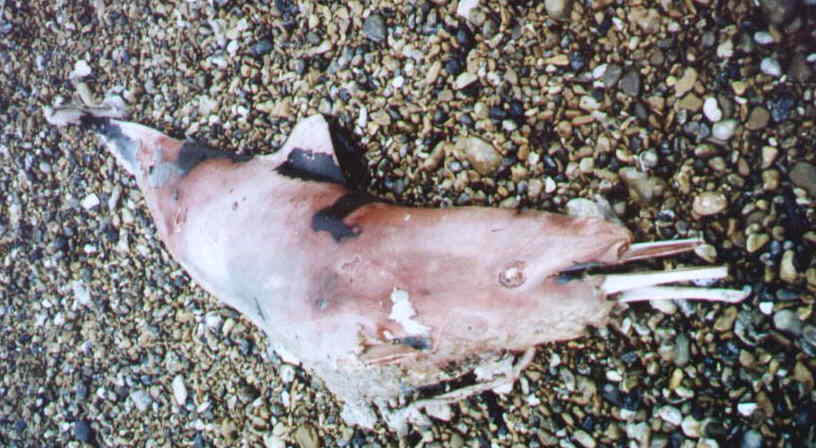
Photograph
by Steve Savage (Sea Watch Foundation)
Click
on the flipper for a close-up
Two
badly decomposed Dolphins were washed up on Shoreham
Beach, Sussex. They were badly decomposed but were probably Common
Dolphins, Delphinus delphis. A Porpoise, just over a
metre long, was washed at nearby Worthing.
Sussex
Dolphins
BMLSS
Cetacea
Sussex
Sea Watch Foundation News 2001

9 February
2002
After
a week of gales, the Mantis Shrimp illustrated
was discovered on the tideline at Calshot Spit, Hampshire. It is probably
Rissoides
desmaresti.
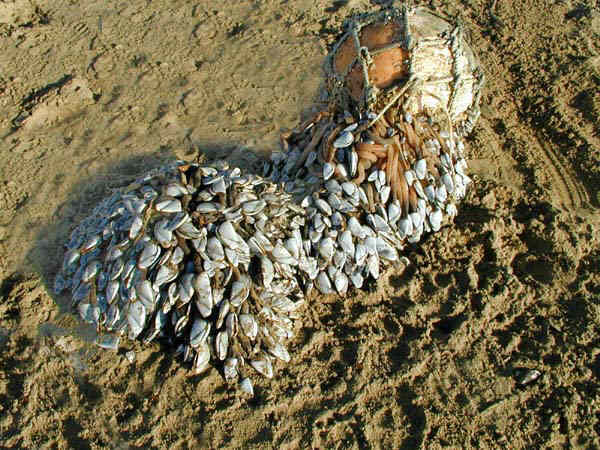
12
February 2002
After
a few days of gales, I discovered my first Goose
Barnacles, Lepas anatifera, on the Gower peninsular, south
Wales, storm shore at Llangenith, after 25 years of searching the strandline.
These are the barnacles in the photograph on the right and they varied
in length rom 25 mm length down to small baby ones of 5 mm - 8 mm.
August
2002
We found four of these big
blue jellyfish, Rhizostoma
octopus, in August washed up on the shoreline of the
River Teign between Newton Abbot and Teignmouth in Devon. My husband has
size 9 feet, so you can tell they were pretty big!
23
June 2003
There
was a mass stranding of 500+ Mauve
Stingers (small jellyfish), Pelagia
noctiluca, at Porthcothan, Cornwall. This is the most unusual of
the British species of pelagic jellyfish to wash up, but large swarms occur
in years of abundance.
Despite
being a small jellyfish, it has a reputation as a stinger,
in the Mediterranean.
Amongst
the Sea Rocket, Orache etc., on the strandline, aPeanut
Plant has taken root.
Masked Crabs, Corystes cassivelaunus, are found often found washed up on the sandy areas of the beach.
Caribbean
(Seeds from the)
Cornish
Fish Strandings
Cuttlefish
& Cuttlebones
Fraisethorpe
and Barmston: largest mass stranding on record
Jellyfish
Page
Mermaid's
Purse
Oil
Spills Page
Portuguese
Man o'War, Physalia physalis, and the By-the-wind Sailor, Velella
velella
Spirula
Torbay
(Mass Stranding in)
UK
Conchology Smart Group
Velella
(Mass Stranding 2002 of this jellyfish-like animal)
 A
Good Introduction
A
Good Introduction
The
Seashore Naturalist's Handbook
Leslie
Jackman
ISBN 0 600 36447 X
This book may be hard to
obtain, although it should be available through the Library system.
Flintman
on Flint (Link)
Hanover
Point, Isle of Wight
Longshore
Drift
Molluscs
page
Orford
Ness: Coastal Ecology of a Shingle Bank (excellent references)
Seashore
Page
|
|
|
|
|
|
|
|
|
News 2018 |
Membership Form |
|